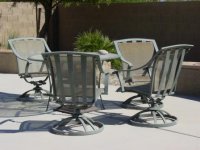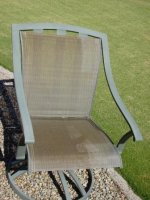OK, I've got to give the thumbs up to the hairdreser's powdered beach & H2O2 mixture. I tried the xantham gum mixture, checked it after four hours and it hadn't done the job. In addition, it was spotty in its coverage. I washed off the pieces and coated them with the H2O2 and powdered bleach mixture and in two hours they were fine. The PB mixture sticks to the verticals better than the XG as well. You just can't use the PB mixture when there's painted parts involved.
Merlin:
You've got to gve this PB mixture a try. It doesn't bubble like the other mixtures though. That makes me think that there isn't enough TAED in the PB mixture. Do you see any danger in adding the Oxy to the PB mix? I'm thinking that could improve the process.
RE: a previous reply of yours regarding garden chairs; I was sitting on the deck after coating the computer casing parts, and was looking at my deck chairs. In Phoenix, AZ we get over 300 days of sunshine per year, so everything weathers badly (incl garden hoses, deck chairs & people). I had chairs that used to be a green color, but after two years in the sunshine, are now brown. I tried a pressure washer on them, and that didn't get them any lighter. I had a little H2O2 solution left over, so I thought what the hell, the chairs are toast, why not try a little of the solution on them?
(The back, far right chair is the one I treated).
Here's what they looked like before:

And here's what they looked like after (top and bottom right side are the sections I treated)

It was just a couple of test patches, but the rest of the chairs will now get the treatment.


